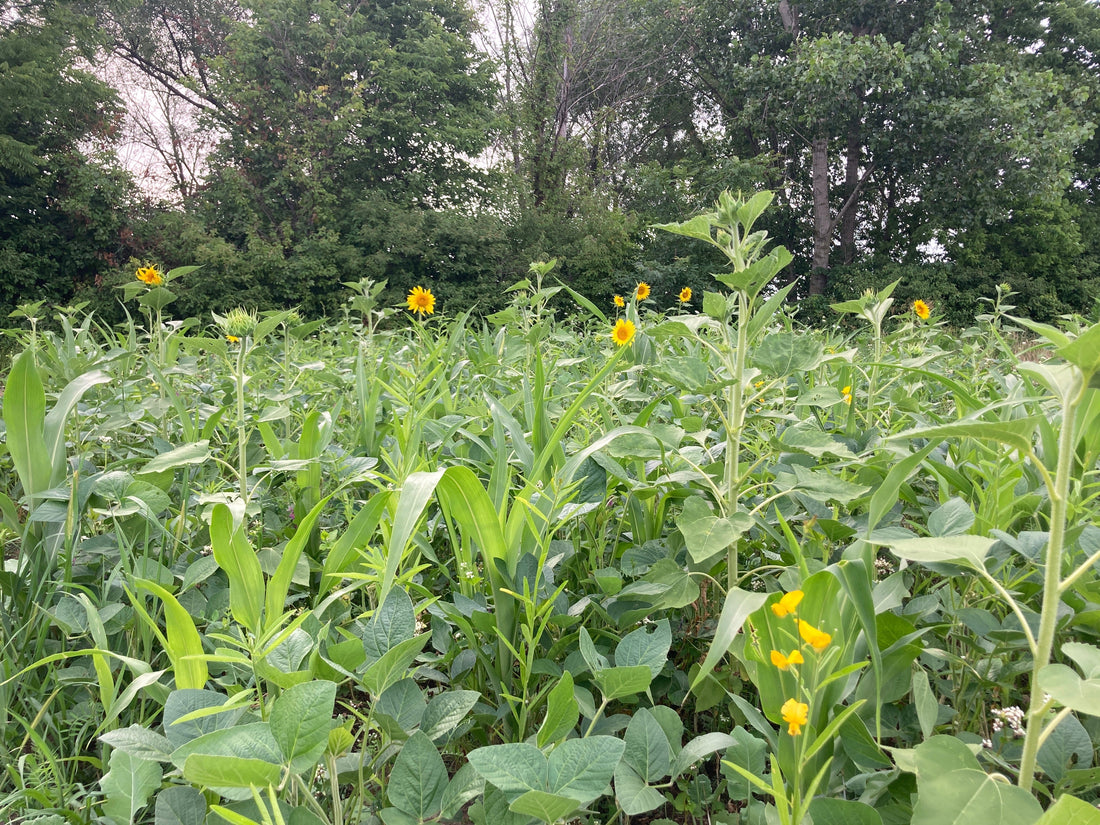
The Protein Trap: Don't fall in!
Share
Every market has its buzzwords, and we're all guilty of using them (myself included). One that gets tossed around constantly is "protein." We're not talking about protein shakes for building gym muscles—we're talking about protein in forage varieties for wildlife and cattle.
Protein is essential for wildlife and livestock nutrition; however, relying on it as the sole benchmark is misleading. On average, deer require about 16% protein in their daily diet, and anything above that is excreted. Keep in mind that around 70-80% of that diet is comprised of natural forages.
If we feed or grow high-protein forages, we can help them hit that 16% target more efficiently—but increasing dietary protein to 30% doesn't bring additional benefits. Deer and cattle must maintain rumen balance, which requires more than protein. Diversity is key to meeting their broad nutritional needs and maintaining digestive health.
The Problem with Protein Percentages
Protein is not a fixed number—it's a dynamic, variable metric influenced by many factors, including:
- Soil fertility: Nitrogen availability, organic matter levels, pH, secondary nutrients (like sulfur), and micronutrients affect a plant's ability to synthesize fully formed proteins.
- Microbial density: As soil diversity increases, microbial life thrives—especially when photosynthesis improves, and fungal populations expand.
- Environmental conditions: Drought, excessive rain, temperature swings, and other stressors all impact how plants grow and what nutrients they contain. For example, crops like Sudan, milo, sorghum, or corn can develop unsafe nitrate levels under high fertilization, stress, or during new growth.
- Plant maturity: Protein content often peaks early and declines as the plant matures. This can happen quickly and skew results, giving the impression of better forage quality based on timing alone.
So, the next time you hear about a high protein content, as a selling point. Ask questions like: Under what conditions was the sample taken? What was the soil like? Was the forage stressed or foliar-fed—before, during, or after sampling? How exactly was the sample collected?
Like-for-Like Forage Comparisons Are Often Flawed
It's common to compare two clovers, brassicas, or cereal grains and make purchasing decisions based solely on protein content. But here's the truth:
Due to differences in soil and management, a single species—like crimson clover—can yield 14% protein in one field and 26% in another just a few miles away. Comparing forages without accounting for these variables leads to poor decisions and misaligned expectations.
Even side-by-side trials can be misleading if soil conditions vary slightly. Protein comparisons without context can be meaningless. And even with context, we need to recognize that some variability is expected. Differences might appear statistically significant but still fall within the accepted range of sampling differences (coefficient of variation).
What Matters More Than Protein?
Several traits are often more critical than crude protein content:
- Digestibility: How much forage can the animal break down and utilize?
- Palatability: Will they eat it readily and consistently? And which part of the plant are they eating? (Especially important for whitetails.)
- Nutrient density: What vitamins, minerals, and phytonutrients are present? Are the proteins fully formed? Are nitrate levels low?
- Plant diversity: Multi-species plots provide more balanced nutrition—crucial for ruminants—and support soil health.
- Resilience and regrowth: How well does the plant handle pressure, and can it recover after grazing? If not, will there be enough food in the landscape for the animals, or will they be stressed?
Soil Health is Key
Your soil determines the quality of your forage. It's the foundation for everything. Healthy soils with robust microbial systems grow more nutritious plants—regardless of the seed variety.
- Microbial symbiosis improves nutrient uptake.
- Biological activity drives organic matter breakdown and mineralization.
- Diverse root systems feed the soil and keep it functioning year-round.
Soil health must be built over time by focusing on sound practices and prioritizing balanced diversity in your fields and native habitat.
To maximize ruminant nutrition, especially for concentrating selectors—we must offer dietary diversity. This goes for both managed fields and natural habitats. Focusing only on "species X vs. species Y" because of a protein claim is shortsighted and sets you up for disappointment.
Take soil tests, follow soil health principles, use exclusion fences, and, most importantly, let the wildlife show you what they want to eat. Never stop measuring, observing, and adjusting.
Thank you for reading! Stay safe and enjoy the outdoors!
-Albert
PS—Don't just take my word for it. Here is a list of references for those who want to investigate further.
References:
-
White-tailed Deer Protein Needs
This article discusses the protein requirements of white-tailed deer, emphasizing the importance of a 14–16% protein diet for optimal growth, antler development, and reproduction.
https://www.deermanagement.us/white-tailed-deer-protein-needs/ -
Nutritional Requirements of White-tailed Deer in Missouri
This publication outlines the varying protein needs of deer based on age and physiological activity, highlighting the necessity of higher protein levels during antler growth and lactation.
https://extension.missouri.edu/publications/g9487 -
Factors Affecting Forage Quality
An in-depth look at how soil fertility, plant maturity, and environmental conditions influence the protein content and overall quality of forage.
https://edis.ifas.ufl.edu/publication/AG161 -
Jones, P. D., Demarais, S., Strickland, B. K., & Edwards, S. L. (2008).
Soil Region Effects on White-tailed Deer Forage Protein Content. Southeastern Naturalist, 7(4), 595–606.
This study examines how different soil regions impact the protein levels in deer forage, demonstrating significant regional variations.
https://www.researchgate.net/publication/232689222_Soil_Region_Effects_on_White-tailed_Deer_Forage_Protein_Content - Pennington. "Crimson Clover." Pennington. Accessed April 11, 2025. https://www.pennington.com/all-products/wildlife/crimson-clover.
